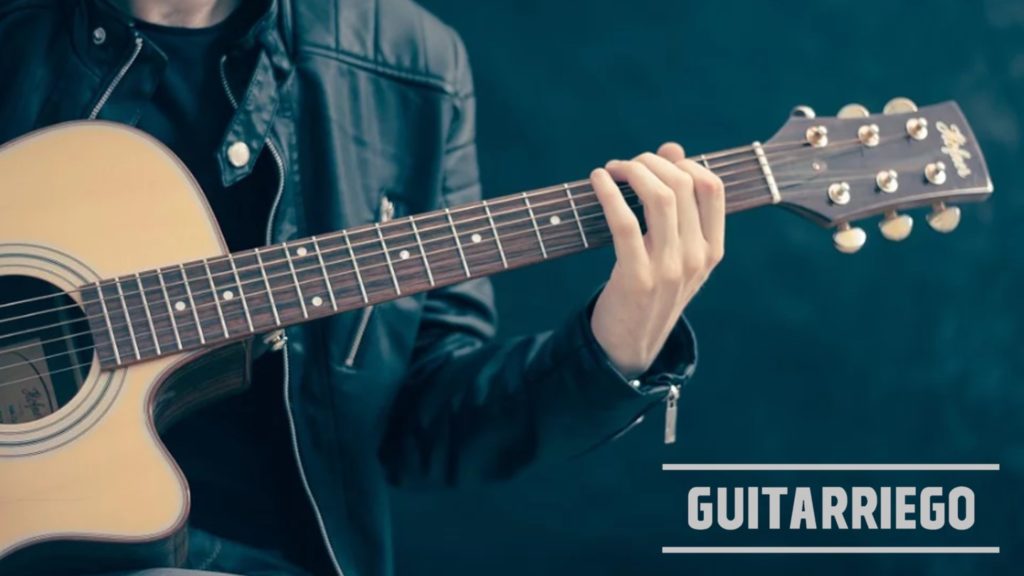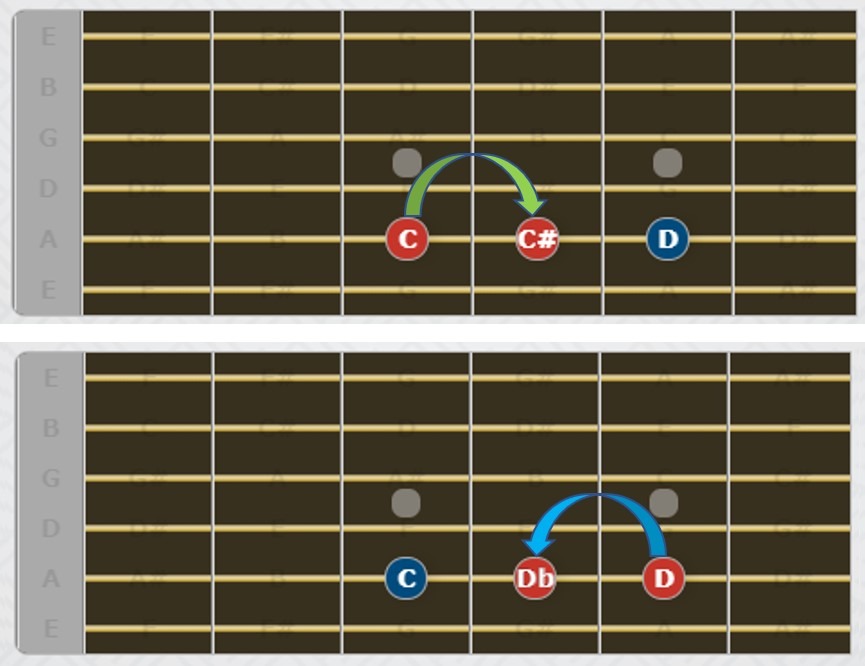Guitar Notes – Location of Musical Notes on the Fingerboard

Guitar notes, to be able to play any musical instrument, you must know well the musical notes and their location, this lesson is ideal for beginning guitarists to learn each note and where they are located on the fretboard.
The musical notes
When we are taught the musical notes on the guitar as children, we are taught seven notes: C, D, E, F, G, A and B. But you are, it’s really not all the musical notes, they are just a part.
So is what they teach us wrong? No, they simply teach us something very basic, incomplete at best but not bad. Actually these seven musical notes are the natural notes. The interesting thing is that these seven musical notes are nothing more than the Natural Major Scale of C.
What they did not teach us, are the 5 notes in harmonics or altered notes, which are the sharps (#) that are C# (C sharp), D#, F#, G# and A#. As you have seen, neither Si nor Mi have sharps.
How many are the musical notes?
So the musical notes in total are 12: C, C#, D, D#, E, F, F#, G, G#, A, A#, B. The 7 natural notes: C, D, E, F, G, A, B and the 5 notes in harmonics or altered notes: C#, D#, F#, G#, A#.
An instrument that visualizes this very well is the piano. Where the white or ivory keys are the natural notes: C, D, E, F, G, A, B and the black keys are the notes in harmonics or altered notes: C#, D#, F#, G#, A#.
The notes in harmonics: Sharps and flats
In addition to identifying harmonic or altered notes with “sharp – #”, they can also be identified with “flat – b”. Both are used interchangeably, the sustain is a semitone or a higher fret, and the flat is a semitone or a lower fret. Thus, the sharp of C is the same note as the flat of D:

Equivalences between sharps and flats
| Sustained | C# | D# | F# | G# | A# |
| Flat | Db | Eb | Gb | Ab | Bb |
Now you know the musical notes, now let’s learn to place them on the guitar fretboard.
Learn easily to locate the notes on the guitar fretboard

Learning the notes on the fretboard is a gradual process. Therefore, we are going to follow the steps of this path. The first thing is to learn the notes of the open strings of the guitar. Take your time to digest each of the steps. Go to the next step once you are sure you have already learned the previous one.
The notes of the open strings in the guitar
The open notes of the guitar are:
| String | 6th. | 5th. | 4th. | 3rd. | 2nd. | 1st. |
| Note | E | A | D | G | B | E |
Below you can see the diagram: above the first string, the thinnest, and below the sixth string, the thickest.

Looking at this, you can see why in the D chord only the first four strings are played, the fourth open is D. Also because in A, you only play the first five strings, the fifth open string is A. In E they are all played, because the sixth string is E.
You can analyze the other chords, and you will see that the thickest string, played, that is the bass, is the same note of the chord. The bass of a chord is the lowest note played. In common chords, always the bass, is the same note. Later on, you will see that you can play a D with bass on B, which is identified with the D / B. But that’s a topic to look at later.
And the notes that are not on the open string?
Let’s analyze F, you will see that the thickest note is the sixth string, first fret. If you know that the E is open, you know that the next E note is F, which is the first fret. You can do the same with the C. The bass of C is the fifth string, fret three. If you know that the fifth string is A, move up three notes, A# is the first, B is the second, C is the third. You can do the same with G and B. This is how you have put together the basic chords that we learned in our previous lesson.
So, remember each note: 6:E 5:A 4:D 3:G 2:B 1:E. Read the following note if you want to learn more about the name of guitar strings from Guitar Quarter.
Notes on the first 3 frets of the guitar
If you have done the chord exercise, you have already started to learn the notes of the first three frets. Below, we see all the notes of the first three frets, marking in red those that you should already know from the previous exercise, since they are the basses of the chords that you already learned in the chords lesson.

The next step to make it easier for you to learn the strings is to locate the octaves. The octave is the way to call the same note but in its highest version. That is, you can locate by reference to a location that you already know, if you know the pattern or relationship that the octaves have. This relationship is the same for the second four strings -strings 6, 5, 4 and 3- and for the first two strings -strings 1 and 2- only one fret is moved.
Octave Relationship: Structures on the Fingerboard
Look at the graph below, you can very easily locate a note from the open strings, you already know them. You can see how the examples were marked with the notes in green and indicating the relationship between octaves through an arrow. So if you move on the thicker strings, the octave is located two frets higher and two strings lower. Thus, the E, has its octave or the next higher or higher E, at fret two, two more than open, or what would be the zero fret, and on string 4, two strings lower than string 6. The same thing happens with A, both are on strings 3 to 6 so the pattern is the same.

The thing changes, with the G, since it is on string 3, but its octave is on string 1, the same with the D that is on string 4 and its octave on string 2. Being in the first two strings, that is, 1 and 2, the relationship changes. You go down two strings, but instead of going up two frets, they have to go up 3 frets.
If you already know how to tune by ear, you will see that this is related to tuning, strings 5, 4 and 3 are tuned by leaning on the top string at the fifth fret, but the second is done at the fourth, so it is changed the relationship between the notes.
Remember to study and learn each step well before moving on to the next.
Learn to use the fingerboard references: The dots or inlays
Before advancing with the frets from the fourth forward, it is important that you make sure that you know the fretboard and its references well. You must be clear that the first point is the third fret, the second point is the fifth fret, the third point is the seventh fret and so on. Below you can see a graph that will make it easier for you to memorize the fretboard and frets well.

Make sure before moving on to the next step, that you learn to position yourself well on the fretboard. Know what fret number each one is using the point reference.
Learn the musical notes on the 6th and 5th string of the guitar
It’s time to learn the notes on strings 6 and 5. Why learn these? First, because normally when you play a chord or a scale, you usually place the tonic or the note on these strings, which is why, for the most part, they are our guides for chords and scales. Second, because with the structure or octave ratio technique, it will allow you to see the notes on the strings below. Also, if you learn the sixth, you are also learning the first, since both are E with the string in the air.
Notes on the sixth string of the guitar

Notice that we mark the natural notes, simply because it is not necessary to know 12, but to know some and the others, in reference to the ones you know, you will deduce them quickly. If you learn that the F is on the first fret, the G is on the third fret, the A is on the fifth fret, and so on. When you need an A#, you can quickly locate it from A, if you need a G#, you will know that it is the next fret to G, that is, the fourth fret.
Notes on the fifth string of the guitar

Follow the same method as the six string, learn to locate the natural notes, since the sharps, flats or notes in harmonics you will easily locate in references to them.
Have you already memorized and learned the steps? If the answer is yes, you already handle three complete strings, 6, 5 and 1 which is equal to the sixth!

Strings 4, 3 and 2 using the octaves
To quickly locate the strings of the missing strings, you can memorize them as strings 6 and 5, or take advantage of the fact that you already know those two strings, to use the octave ratio method again.
Knowing that you can find the note using the octaves from string 6 and 5 that you already learned, you know that finding on string 4 the octave of the notes on string 6 two frets higher -and two strings lower- and the same with the notes on string 3 using the reference for the notes on string 5.

For string 2, we add another new octave ratio. If you start from the fifth strings, if you lower three strings and lower two frets, you will reach the eighth of the note. In this way, knowing the notes of strings 6 (and 1) and 5, you can locate the musical notes of the entire fingerboard with these two octave ratios.
Musical notes on frets 12 to 21, 22 or 24
At the 12th fret, all notes begin the same on air. The point after the double point is on the 15th fret and works the same as the 3rd fret, so if you do a transport, you will quickly see that you already know all the musical notes on the fretboard.

Now that you know the musical notes across the entire guitar fretboard, you are ready to move on to the Basic guitar scales for beginners!
You can share opinions or also chat about this and more with other musicians in our comments section.






